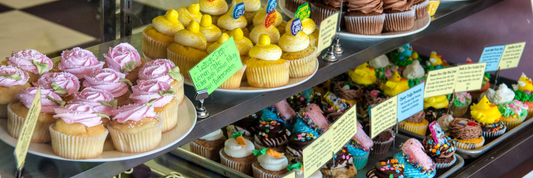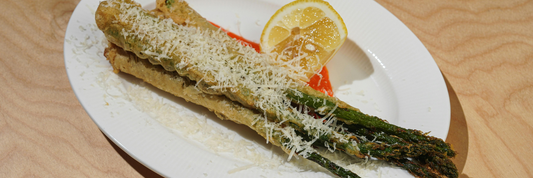The world of artisan baking is evolving and 2025 is shaping up to be one of the most creative years yet. Bakeries are blending global inspirations with local ingredients, experimenting with textures, and embracing sustainability in every detail, from recipe design to presentation.
In this article, you’ll explore the top artisan bread, pastry, and dessert trends for 2025, plus simple ways to bring them into your bakery kitchen.
At KimEcopak, we’ve seen how eco-friendly packaging can elevate presentation while supporting a bakery’s sustainability goals.
- Top Food and Beverage Trends Shaping Canada's F&B Industry in 2025
- Baguette vs French Bread: How to Choose the Right Loaf for Any Meal
Flavor Innovation Defines Artisan Bread, Pastry, and Dessert Trends 2025

Global Inspiration Meets Local Ingredients
Artisan bakers are looking beyond traditional recipes. Expect to see Japanese matcha brioche, Mediterranean herb focaccia, and Vietnamese coffee tarts a fusion of global tastes with local identity.
In Canada, bakeries are highlighting regional ingredients like maple syrup, wild blueberries, and Red Fife wheat to create signature items that feel both familiar and new.
Plant-Based and Functional Baking
Vegan, dairy-free, and gluten-free options are no longer niche, they’re expected. Bakeries are now experimenting with:
- Alternative flours: spelt, buckwheat, chickpea
- Natural sweeteners: date paste, coconut sugar, honey
- Functional ingredients: chia, flaxseed, or oats
These health-forward choices let customers indulge guilt-free and look beautiful when served in paper boxes or ice cream cups perfect for both takeout and dine-in experiences.
Texture and Visual Appeal Take Center Stage
Multi-Layered and Hybrid Pastries
The “hybrid pastry” trend is still going strong in 2025. Think cube croissants, crookies, or cruffins all built to intrigue customers visually and satisfy them texturally.
Bakers are perfecting laminated doughs and layering techniques to create pastries that look like art and taste like comfort.
Elevating Presentation with Sustainable Packaging
Visual storytelling extends beyond the display case. Many bakeries are embracing minimalist, recyclable packaging such as kraft paper boxes or compostable clamshells that showcase their products’ textures while aligning with sustainability values.
Explore more: Sustainable Bakery Packaging Ideas That Boost Sales
Sustainability Shapes the Future of Artisan Baking

Responsible Sourcing and Waste Reduction
In 2025, sustainability has evolved from a nice-to-have into a core bakery business strategy. Today’s artisan bakers aren’t just focused on flavor and texture, they’re also deeply committed to how their ingredients are sourced and how their operations impact the environment.
Across Canada and the U.S., small bakeries are turning toward local suppliers and regenerative agriculture. Using regionally milled flours, organic dairy, and locally grown fruits reduces transportation emissions and supports the local economy a win-win for sustainability and storytelling. A loaf of sourdough made with Prairie-grown wheat or a tart filled with Ontario apples tells a local story customers can connect with.
Another growing movement is upcycling ingredients using leftover bread for croutons, day-old pastries for bread pudding, or coffee grounds in chocolate desserts. These small changes not only reduce food waste but also spark creativity and innovation in the kitchen. Many bakeries even compost their food scraps or partner with farms to reuse organic waste, closing the loop on their environmental impact.
Sustainability extends beyond ingredients. Energy-efficient ovens, LED lighting, and optimized baking schedules are helping bakeries lower energy costs. And when it comes to packaging, more businesses are making the switch to compostable containers and kraft paper boxes that look great, perform well, and align with eco-conscious values.
Transparency and Simple Design
The modern consumer wants honesty in both what they eat and how it’s presented. Transparency has become a defining value for artisan brands. Bakeries that clearly list their ingredients, source origins, and sustainability practices earn trust and loyalty from an increasingly informed audience.
In packaging, this transparency shows up through minimalist, natural materials. Instead of glossy plastics or heavy prints, bakeries are opting for unbleached kraft boxes, compostable pastry trays, and paper wraps made from renewable resources. These choices not only reduce environmental impact but also communicate authenticity the same authenticity customers expect from handcrafted bread and desserts.
Clean, simple packaging design has another advantage: it complements the artisanal aesthetic. When customers open a kraft windowed bakery box or a compostable clamshell container, the focus remains where it belongs on the product’s texture, color, and craftsmanship. The packaging becomes part of the brand’s visual language: natural, thoughtful, and purposeful.
In short, sustainability in artisan baking is no longer limited to “eco-friendly materials.” It’s an entire mindset one that connects sourcing, production, and presentation in a seamless, responsible ecosystem. Bakeries that bake consciously, package sustainably, and communicate transparently are the ones leading the next generation of artisan food culture.
Technology and Personalization in Dessert Trends 2025
Smart Tools for Efficient Kitchens
In 2025, technology continues to reshape how artisan bakeries operate behind the scenes. Once dominated by intuition and manual precision, modern bakeries are now embracing smart tools and data-driven systems that help bakers work faster, safer, and more sustainabl without compromising craft.
Digital proofing cabinets, precision thermometers, and temperature-controlled mixers are helping bakers maintain consistency across batches. These tools save hours of trial and error, especially for delicate doughs and laminated pastries that demand precision. Some bakeries are even integrating AI-assisted recipe trackers that monitor fermentation or ingredient ratios in real time, ensuring every loaf or tart meets exact quality standards.
On the customer side, online ordering platforms and inventory management apps have become essential. They streamline operations, reduce administrative stress, and allow small bakeries to forecast demand more accurately minimizing waste and keeping products fresh.
Even something as simple as a tablet-based point-of-sale system can make daily operations smoother and more transparent, allowing staff to focus on creativity and customer interaction.
Digital efficiency, when applied thoughtfully, frees up time for what truly matters: craftsmanship and connection.
For practical strategies, read How to Improve Workflow Efficiency in Your Bakery Kitchen.
Customization and Experience-Driven Offerings
The artisan dessert scene in 2025 is not just about flavor, it’s about experience. Today’s consumers want more than a delicious pastry; they crave a sense of participation, creativity, and personalization in what they buy.
This shift has led to the rise of custom dessert bars, tasting menus, and DIY baking kits. Imagine a bakery offering “design-your-own éclair” stations, or pre-packed cookie decorating kits that families can enjoy at home. These interactive offerings help bakeries connect with customers on a deeper level turning one-time buyers into loyal community members.
Customization also extends to packaging and presentation. Bakeries are increasingly offering personalized labels, custom print sleeves, or eco dessert boxes for gifting and celebrations. The packaging itself becomes part of the story: sustainable, thoughtful, and tailored to each order. Choosing materials like kraft windowed boxes or compostable dessert containers not only enhances the aesthetic but also reinforces an eco-conscious message that modern consumers value.
This trend toward personalization is especially powerful for local, independent bakeries. By offering curated experiences from workshops and pop-ups to custom celebration boxes these businesses stand out against mass-market brands. It’s a way to blend creativity, craftsmanship, and community connection all key pillars of the artisan identity.
Ultimately, technology and personalization work hand in hand: smart tools keep the kitchen running efficiently, while customized experiences bring customers closer to the brand. Together, they form the blueprint for the next era of artisan baking one that values innovation just as much as authenticity.
FAQ about Artisan Bread, Pastry & Dessert Trends 2025

Q1. What are the biggest artisan baking trends in 2025?
Global fusion flavors, layered textures, sustainability, and smart technology are shaping the artisan baking scene this year.
Q2. How can small bakeries keep up affordably?
Start with one or two trend-driven menu items and choose simple, eco packaging solutions that fit your brand.
Q3. Why are sustainable materials trending in packaging?
They align with consumer values, reduce environmental impact, and enhance a bakery’s premium, handcrafted image.
Conclusion
Artisan baking in 2025 celebrates craftsmanship, creativity, and conscious business practices. By embracing global flavors, mindful sourcing, and eco-friendly presentation, bakeries can thrive in both flavor and sustainability.
For Canadian bakeries looking to match the trends with smart packaging choices, KimEcopak offers a full range of sustainable solutions that pair beautifully with modern artisan creations.
-
LEARN MORE about How "Subscribe for a Happy Life" will benefits your business HERE!
-
LEARN MORE about Kim Vu, sharing on the challenges she faced as a former restaurant owner, and how she overcame them to create KimEcopak HERE!




